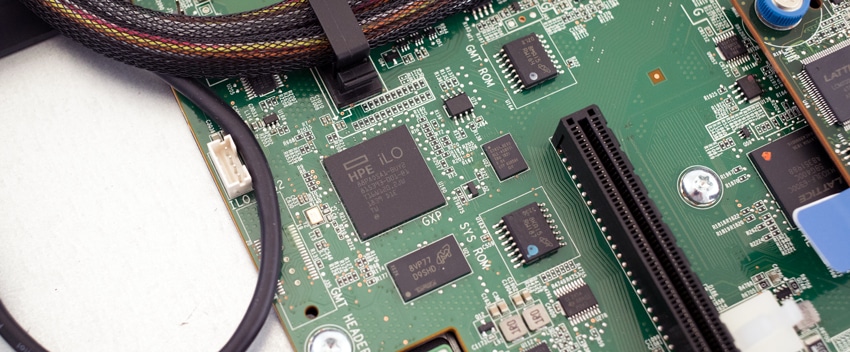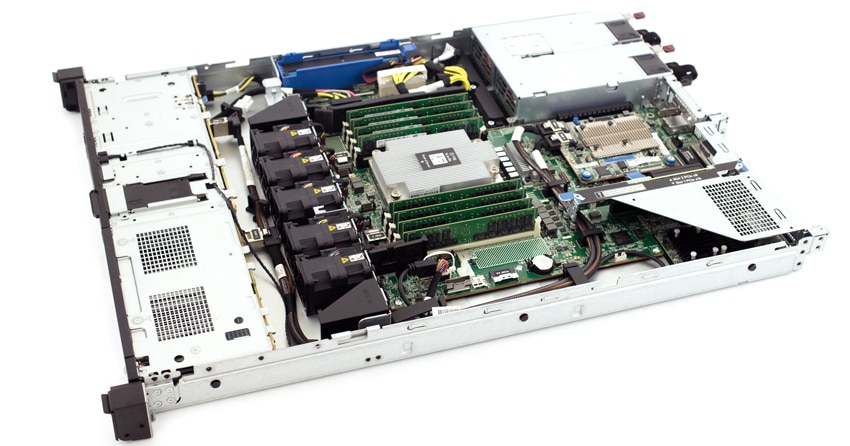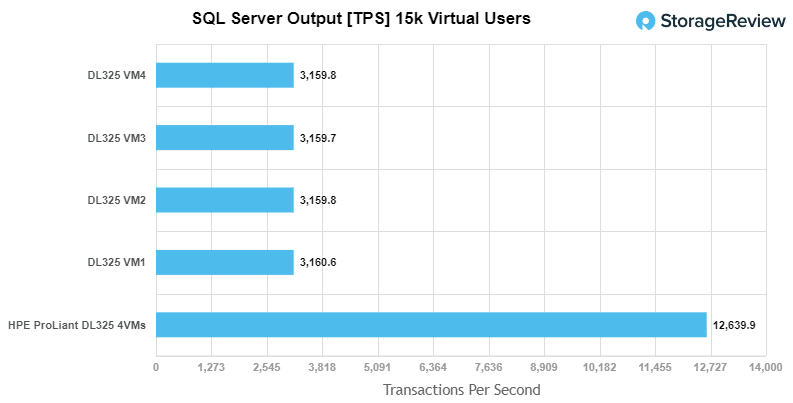The HPE ProLiant DL325 Gen10 one-socket 1U rack profile server is highlighted by its 2nd-gen AMD EPYC 7000 Series processor, which significantly increases performance compared to the previous generation AMD EYPC CPU. It has been a while since we reviewed a server from the ProLiant line (the last being the DL360), so we were eager to get our hands on this thing and see what it can do. As such, HPE has put a huge focus on intelligent automation, security and optimization for its newest iteration of the power-driven server line, adding more cores and faster memory bandwidth. The DL325 also server offers up to 8 SFF, 10 SFF, and 4 LFF drive configurations and 3 PCIe 3.0 slots for further expansion.

Diving into the features and specifications show some significant improvements to the DL325 over previous models. For example, its new AMD EPYC 7xx2 Series 7nm processor allows users to equip the server with up to 64 cores and 128 threads so they can run more multithreaded simulations/single-threaded workloads simultaneously and more effectively. HPE has also indicated faster application performance with memory speeds quoted to reach 2933 MT/s. It also supports S100i Smart Array Controllers and, as we indicated above, up to ten low latency NVMe drives to further drive performance. In addition, the embedded SATA HPE Smart Array S100i Controller comes standard with all builds, giving organizations option to upgrade their server to a 12 Gbps controller. Other bandwidth options include the HPE FlexibleLOM and PCIe standup adapters (from 1GbE to 4x10GbE) so organizations can scale as needed.
As far as security goes, the DL325 has you covered. For example, its “Silicon Root of Trust” in the iLO silicon validates all vital systems, such as firmware, BIOS and software, to ensure a “known good state,” while its dedicated AMD security processor is embedded in the AMD EPYC system on a chip (SoC). This allows the DL325 to support secure boots, virtualization and memory encryption. Moreover, its Run Time Firmware Validation validates the iLO and UEFI/BIOS firmware during runtimes, and will alert users of automated recoveries when it identifies compromised firmware.
The DL325 offers a variety of automation features as well, including HPE’s Integrated Lights-Out (HPE iLO 5 Review) server management technology, which monitors servers for ongoing/remote management, service alerting, and reporting. This allows users to effectively (and remotely) resolve any issues that might arise, so the IT team can manage the servers from anywhere around the globe, driving down operational costs by eliminating on-site visits. Moreover, HPE OneView automates tasks by transforming compute, storage, and networking into software-defined infrastructure, while InfoSight provides a built-in, proactive AI that can anticipate problems before they even occur.
HPE ProLiant DL325 Server Specifications
| AMD EPYC Processor | Cores | Base Frequency | Max Frequency | Max Memory | Wattage | Cache | Memory |
| AMD EPYC 7xx2 Series Processor Family | |||||||
| EPYC 7702P | 64 | 2.0Ghz | 3.35Ghz | 2TB | 200 | 256MB | 2933MT/S |
| EPYC 7702 | 64 | 2.0Ghz | 3.35Ghz | 2TB | 200 | 256MB | 2933MT/S |
| EPYC 7502P | 32 | 2.5Ghz | 3.35Ghz | 2TB | 180 | 128MB | 2933MT/S |
| EPYC 7452 | 32 | 2.35Ghz | 3.35Ghz | 2TB | 155 | 128MB | 2933MT/S |
| EPYC 7402P | 24 | 2.8Ghz | 3.35Ghz | 2TB | 180 | 128MB | 2933MT/S |
| EPYC 7302P | 16 | 3.0Ghz | 3.3Ghz | 2TB | 155 | 128MB | 2933MT/S |
| EPYC 7262 | 8 | 3.2GHz | 3.4GHz | 2TB | 155 | 128MB | 2933MT/S |
| AMD EPYC Processor | Cores | Base Frequency | Max Frequency | Max Memory | Wattage | Cache | Memory | ||
| AMD EPYC 7xx1 Series Processor Family | |||||||||
| EPYC 7601 | 32 | 2.2GHz | 3.2GHz | 2TB | 180 | 64MB | 2666MT/S | ||
| EPYC 7551P | 32 | 2.0GHz | 3.0GHz | 2TB | 180 | 64MB | 2666MT/S | ||
| EPYC 7501 | 32 | 2.0GHz | 3.0GHz | 2TB | 155/170 | 64MB | 2666MT/S | ||
| EPYC 7451 | 24 | 2.3GHz | 3.2GHz | 2TB | 180 | 64MB | 2400/2666MT/S | ||
| EPYC 7401P | 24 | 2.0GHz | 3.0GHz | 2TB | 155/170 | 64MB | 2400/2666MT/S | ||
| EPYC 7351P | 16 | 2.4GHz | 2.9GHz | 2TB | 155/170 | 64MB | 2400/2666MT/S | ||
| EPYC 7301 | 16 | 2.2GHz | 2.7GHz | 2TB | 155/170 | 64MB | 2400/2666MT/S | ||
| EPYC 7281 | 16 | 2.1GHz | 2.7GHz | 2TB | 155/170 | 32MB | 2400/2666MT/S | ||
| EPYC 7261 | 8 | 2.5GHz | 2.9GHz | 2TB | 155/170 | 64MB | 2400/2666MT/S | ||
| EPYC 7251 | 8 | 2.1GHz | 2.9GHz | 2TB | 120 | 32MB | 2400MT/S | ||
| EPYC 7371 | 16 | 3.1GHz | 3.8GHz | 2TB | 155/170 | 64MB | 2400/2666MT/S | ||
| Chipset | No chipset – System on Chip (SoC) design. |
| On System Management Chipset
|
HPE iLO 5 ASIC
NOTE: Read and learn more in the iLO QuickSpecs. |
| Memory | |
| Type: | HPE DDR4 SmartMemory, Registered (RDIMM), Load Reduced (LRDIMM)
DIMM Slots Available: 16 DIMM slots per processor, 8 channels per processor, 2 DIMMs per channel |
| Maximum capacity (LRDIMM) | 2.0 TB: 16 x 128 GB LRDIMM @ 2666 MT/S
Maximum capacity (RDIMM) – 1.0 TB 16 x 64 GB RDIMM @ 2666 MT/S |
| Slots # | Technology | Bus Width | Connector Width | Slot Form Factor | Notes |
| 1 | PCIe 3.0 | X16 | X16 | Full-height, full-length slot | Proc 1 |
| 2 | PCIe 3.0 | X8 | X8 | Low Profile | Proc 1 |
| Slots # | Technology | Bus Width | Connector Width | Slot Form Factor | Notes |
| 1 | PCIe 3.0 | X16 | X16 | Low Profile | Proc 1 |
| Storage Controllers
|
The Gen10 controller naming framework has been updated to simplify identification as depicted below. For a more detailed breakout of the available Gen10 Smart Array controllers visit the HPE Smart Array Gen10 Controllers Data Sheet.
One of the following depending on model |
|
Software RAID |
HPE Smart Array S100i SR Gen10 SW RAID
|
| Essential RAID Controller | · HPE Smart Array E208i-a SR G10 LH Controller
· HPE Smart Array E208e-p SR Gen10 Controller |
| Performance RAID Controller | · HPE Smart Array P408i-a SR G10 LH Controller
· HPE Smart Array P408e-p SR Gen10 Controller · HPE Smart Array P816i-a SR G10 LH Controller |
| Maximum Internal Storage | ||
| Capacity | Configuration | |
| Hot Plug SFF SAS | 24.0 TB | 8+2 x 2.4 TB (with optional 2SFF drive cage) |
| Hot Plug SFF SATA | 20.0 TB | 8+2 x 2 TB (with optional 2SFF drive cage) |
| Hot Plug LFF SAS | 56 TB | 4 x 14 TB |
| Hot Plug LFF SATA | 56 TB | 4 x 14 TB |
| Hot Plug SFF SAS SSD | 153 TB | 8+2 x 15.3 TB (with optional 2SFF drive cage) |
| Hot Plug LFF SATA SSD | 7.68 TB | 4 x 1.92 TB |
| Hot Plug SFF SATA SSD | 76.8 TB | 8+2 x 7.68 TB (with optional 2SFF drive cage) |
| Hot Plug SFF NVMe PCIe SSD | 153.6 TB | 8+2 x 15.36 TB |
| Maximum Internal Storage | ||
| Capacity | Configuration | |
| Hot Plug SFF SAS | 24.0 TB | 8+2 x 2.4 TB (with optional 2SFF drive cage) |
| Hot Plug SFF SATA | 20.0 TB | 8+2 x 2 TB (with optional 2SFF drive cage) |
| Hot Plug LFF SAS | 56 TB | 4 x 14 TB |
| Hot Plug LFF SATA | 56 TB | 4 x 14 TB |
| Hot Plug SFF SAS SSD | 153 TB | 8+2 x 15.3 TB (with optional 2SFF drive cage) |
| Hot Plug LFF SATA SSD | 7.68 TB | 4 x 1.92 TB |
| Hot Plug SFF SATA SSD | 76.8 TB | 8+2 x 7.68 TB (with optional 2SFF drive cage) |
| Hot Plug SFF NVMe PCIe SSD | 153.6 TB | 8+2 x 15.36 TB |
| Power Supplies | ||
| HPE 500W Non Hot Plug Low Halogen FIO Power Supply
NOTE: Available in 92% efficiency. |
||
| HPE 500W Flex Slot Platinum Hot Plug Low Halogen Power Supply Kit
NOTE: Available in 94% efficiency. |
||
| HPE 800W Flex Slot Platinum Hot Plug Low Halogen Power Supply Kit
NOTE: Available in 94% and 96% efficiency. NOTE: Also available in -48VDC and 227VAC/380VDC power inputs. |
||
| HPE 1600W Flex Slot Platinum Hot Plug Low Halogen Power Supply Kit
NOTE: Available in 94% efficiency. NOTE: 240v power input only. |
||
| The HPE 500W FIO Power Supply offers Gold-certified 80 Plus power efficiency up to 92% with an optimized set of features for non-redundant power configurations for Gen10 ProLiant ML 10/100 Series Servers, as well as ML350 Gen10 and DL325 Gen10. | ||
Design and build
The HPE ProLiant DL325 Gen10 is a one-socket 1U rack profile server, with all functionality and drive access located on the front panel. Users have the option of three chassis types:
- 8 SFF with optional Optical Drive, 2 SFF SAS/SATA or 2 NVMe drive bay options
- 8 SFF NVMe with optional Optical Drive 2 SFF SAS/SATA or 2 NVMe drive bay options
- 4 LFF with an optional Optical Drive bay

Depending on which chassis you choose, the layout of the front panel will be different; for this review, we will look at the 8 SFF configuration. On the right side is the Power On/Standby button and the system power, Health and UID LEDS, as well as the iLO Service Port. Just to the left is the optional media bay (surrounded by the drive bays), while the quick removal access panel is located at the right top corner of the front panel.
This is a solidly build server and access to all main components are quick and easy.

On the inside, we have the fan cages facing the drive bays, which house up to 5 performance hot-swappable fans to keep this system cool and running well. Next to the fans are the DDR4 DIMM slots (up to 16) that surround the processor and heatsink horizontally. Just to the right are the hot plug redundant HPE Flexible Slot Power supplies and the Optional HPE Flexible Smart Array Controller. Below that is the PCI riser, which comes standard, as well as the flexible LOM slot, which is optional.

Along the top of the back panel are the three standard PCIe 3.0 slots (the far right slot being optional) and two HPE Flexible Slot power supply bays. The bottom houses all the connectivity, including the optional FlexibleLOM (4x 1GbE), VGA port, embedded 4x 1GbE Adapter (if the user equips it), iLO Management Port and dual USB 3.0 ports.
HPE ProLiant DL325 Configuration
For our synthetic and application testing on the HPE ProLiant DL325 we tested a configuration equipped with an AMD EPYC 7702 CPU, 8 x 32GB 2933MHz DDR4 memory, as well as two HHHL NVMe SSDs giving the platform just under 6TB of high-performance storage. We used VMware ESXi 6.7u3 for the Hypervisor to operate our SQL and Sysbench VMs for testing.
Performance
SQL Server Performance
StorageReview’s Microsoft SQL Server OLTP testing protocol employs the current draft of the Transaction Processing Performance Council’s Benchmark C (TPC-C), an online transaction processing benchmark that simulates the activities found in complex application environments. The TPC-C benchmark comes closer than synthetic performance benchmarks to gauging the performance strengths and bottlenecks of storage infrastructure in database environments.
Each SQL Server VM is configured with two vDisks: 100GB volume for boot and a 500GB volume for the database and log files. From a system resource perspective, we configured each VM with 16 vCPUs, 64GB of DRAM and leveraged the LSI Logic SAS SCSI controller. While our Sysbench workloads tested previously saturated the platform in both storage I/O and capacity, the SQL test looks for latency performance.
This test uses SQL Server 2014 running on Windows Server 2012 R2 guest VMs, and is stressed by Dell’s Benchmark Factory for Databases. While our traditional usage of this benchmark has been to test large 3,000-scale databases on local or shared storage, in this iteration we focus on spreading out four 1,500-scale databases evenly across our servers.
SQL Server Testing Configuration (per VM)
- Windows Server 2012 R2
- Storage Footprint: 600GB allocated, 500GB used
- SQL Server 2014
- Database Size: 1,500 scale
- Virtual Client Load: 15,000
- RAM Buffer: 48GB
- Test Length: 3 hours
- 2.5 hours preconditioning
- 30 minutes sample period
For our transactional SQL Server benchmark, the HPE DL325 showed an aggregate score of 12,639.87 TPS while individual VMs ranged from 3,159.71 TPS to 3,160.63 TPS.

With SQL Server average latency the SR570 gave us an aggregate score of 3.5ms with individual VMs ranging from 2ms to 4ms.

Sysbench MySQL Performance
Our first local-storage application benchmark consists of a Percona MySQL OLTP database measured via SysBench. This test measures average TPS (Transactions Per Second), average latency, and average 99th percentile latency as well.
Each Sysbench VM is configured with three vDisks: one for boot (~92GB), one with the pre-built database (~447GB), and the third for the database under test (270GB). From a system resource perspective, we configured each VM with 16 vCPUs, 60GB of DRAM and leveraged the LSI Logic SAS SCSI controller.
Sysbench Testing Configuration (per VM)
- CentOS 6.3 64-bit
- Percona XtraDB 5.5.30-rel30.1
- Database Tables: 100
- Database Size: 10,000,000
- Database Threads: 32
- RAM Buffer: 24GB
- Test Length: 3 hours
- 2 hours preconditioning 32 threads
- 1 hour 32 threads
With the Sysbench OLTP, we tested 4VMs where the HPE DL325 had an aggregate of 8,071.8 TPS.

With Sysbench latency the server had an average of 15.87ms.

In our worst-case scenario (99th percentile) latency, the HPE DL325 posted 29.84ms.

Conclusion
The HPE ProLiant DL325 Gen10 is a security-focused, one-socket 1U rack server designed to thrive in virtualization and I/O intensive workloads. Centered around the latest AMD EPYC 7xx2 Series processors, the DL325 offers users a variety of useful build options, including up to 10 SFF (all NVMe optional) or 4 LFF drive configurations, as well as up to 3 PCIe 3.0 slots. Both small offices to larger enterprises will find a lot to like here, as this compact server can be outfitted with 2TB of RAM and up to 153TB of capacity, depending on the drive configuration.
For our application workload analysis tests, we equipped the HPE ProLiant DL325 with the EPYC 7702 CPU (64 cores @ 2.0Ghz) and 256GB of 2933MHz RAM, along with two NVMe HHHL SSDs for the performance testing storage. This configuration was able to hit aggregate scores of 12,639.87 TPS and an average latency of 3.5ms in SQL Server benchmarks. In Sysbench, the HPE sever recorded an impressive average TPS score of 8,071.8 with average latency of 15.9ms and worst-case scenario latency of 29.84ms.
We are always glad to see competitive offerings continuing to expand in the enterprise server space, as the HPE ProLiant DL325 Gen10 is a versatile server that can meet the demands of both small and large organizations. Moreover, its 2nd gen AMD EPYC processors offer a strong alternative to the Intel lineup you often see in servers of this class. Currently, pricing or feature comparisons can make either side competitive (AMD vs Intel); however, for licensing cost differences, AMD-based servers are looking very nice for businesses looking to optimize their server platform investment.




 Amazon
Amazon